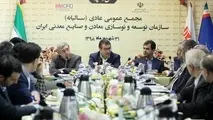Joining Eurasian Union; New Gateway for Iranian Economy
Iranian President Hassan Rouhani's visit to Armenia to attend the Eurasian Union summit at this critical juncture could be of particular importance for Tehran's ties with countries of the region, especially in the economic field.

Iranian President Hassan Rouhani's visit to Armenia to attend the Eurasian Union summit at this critical juncture could be of particular importance for Tehran's ties with countries of the region, especially in the economic field.
Mr. Rouhani will travel to Armenia on Monday afternoon at the head of a high-profile delegation to attend the Eurasian Union summit.
In addition to delivering a speech in the summit and outlining "our country's wide-ranging capabilities to trade with the Eurasian Union", the President will also hold bilateral meetings with the Armenian Prime Minister and other senior officials of that country to focus on the most important issues in Tehran-Yerevan relations and the latest state of implementation of the agreements and joint projects.
President Rouhani will also hold separate meetings with some of the leaders at the summit of the Eurasian Economic Union, during which he will discuss the most important issues of mutual interest as well as regional and international developments.
In 2016, Iran proposed to the Eurasian Economic Commission the creation of a free trade zone between Iran and the Union; a proposal that was welcomed by its members, and during two years of numerous negotiations and quantitative and qualitative evaluation of items and amount of preferential tariffs, the agreement was finally signed on May 17, 2018 in Astana, Kazakhstan.
Primary goals of forming Eurasian Union
The Eurasian Economic Union's initial formation agreement was signed on May 29, 2014 between Russia, Belarus, and Kazakhstan, replacing the Eurasian Customs Union, and then Armenia and Kyrgyzstan joined afterward.
The union officially began its work on January 1, 2015. Eurasian member-states now have an area of 20 million square kilometers and a population of more than 183 million, accounting for 2.5 percent of the world's population. On the day of implementation of the agreement, Russian President Vladimir Putin announced that "today we have created a powerful and attractive economic growth center"; a regional market that connects more than 180 million people.
The objectives of this economic union can be facilitated by trade, the creation of a common market in the CIS, the gradual elimination of customs rules within the Union, the establishment of a common foreign tariff among member-states and the harmonization of customs formalities.
An important opportunity for Iran
Given the diversity of the market and the variety of resources available in the Union’s member-states, joining it creates a significant opportunity for the Iranian economy and can thus offset some of the effects of the sanctions. Of course, joining the Eurasian Economic Union and working with the Eurasian Economic Union could be a new gateway for the Iranian economy that could easily establish economic ties with other members or develop its own.
Joining the union has many economic advantages for Iran, including tariff discounts for Iranian exporters to the Eurasian Economic Union. Also, since the Eurasian Union increased its share of national currency trade payments by 70% by reducing the use of the dollar, there can be optimism on reducing the use of the dollar in trade, which is promising in the current sanctions situation for Iranian businessmen.
Since late 2015, intense negotiations have been held between the Iranian governments with the five members of the Eurasian Economic Union to establish a temporary free trade zone for a three-year trial period, which was finally signed in Astana, the capital of Kazakhstan, on May 18, 2018 by the Minister of Industry, Mining and Trade of Iran then and the cabinet minister approved the bill on December 9, 2018.
The agreement, which came to fruition after two years of negotiations, comes into effect on November 23. A full-fledged free trade agreement is to be signed with Eurasia, and three years later almost all goods will be subject to tariff reductions.
Under the agreement, Iran will receive special customs privileges from the Eurasian Economic Union and the union’s member-states will be able to increase their exports to Iran by up to 75%. Iran can also increase the exports of its goods to five Eurasian countries by as many concessions as it receives.
These privileges include 502 items in the field of food, chemicals, construction products, export of technical and engineering services, industrial products and agricultural products by the Eurasian Union, and 360 items in the same cases by Iran, which include a total of 862 items covered by the agreement.
The benefits of Iran's joining the Eurasian Economic Union include the creation of a bridge linking the market with more than 180 million people and a potential market to boost exports. Also, only Russia, the largest country in the Eurasian Union, puts a 140 million-people market before Iranian businessmen. The region's gross domestic product totaled $1.9 trillion, accounting for 3.2% of world GDP.
Although there are currently only five countries as members of the union, more than 40 countries and international organizations, including China, Indonesia, South Korea, India, Egypt, Serbia and even some Latin American countries, are ready to work within the union.
Iran's accession to the Eurasian Economic Union will lead to a major jump in Iran's oil and non-oil exports.
Membership in the Eurasian Economic Union, which has a brilliant prospect, could play an important role in Iran's crossing of economic bottlenecks. Given the potential for trade between Iran and the Eurasian Economic Union, it should be noted that the union has the potential to become a large and reliable market for Iranian export commodities.



